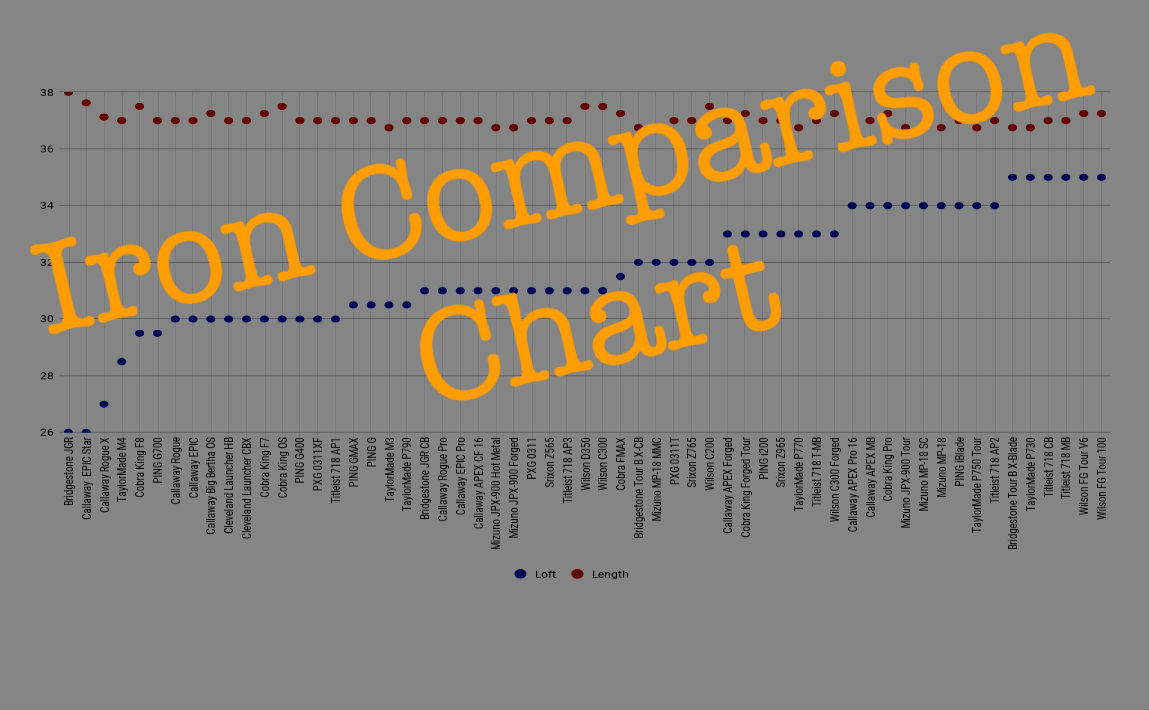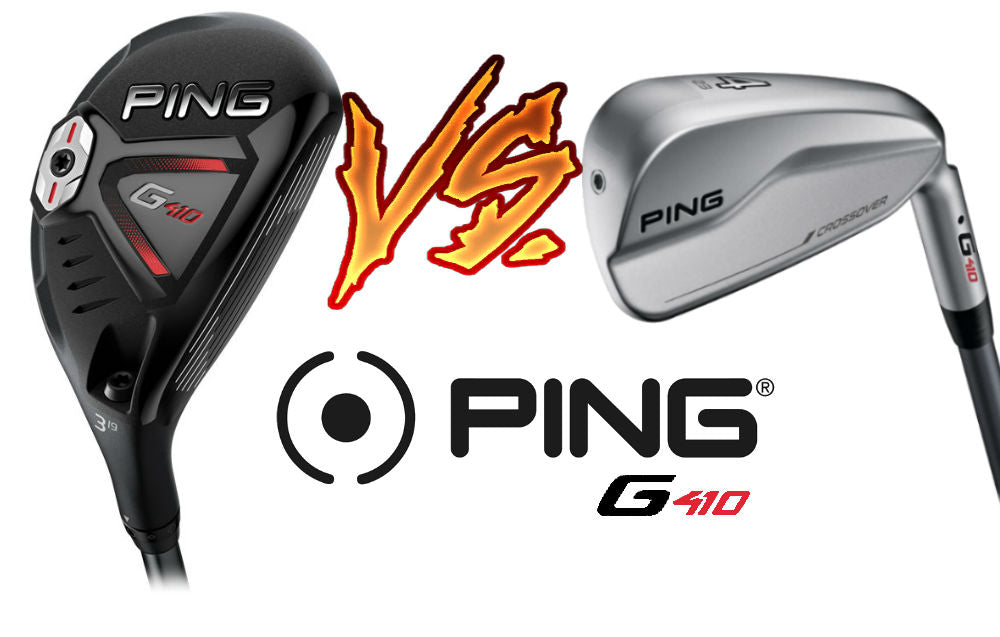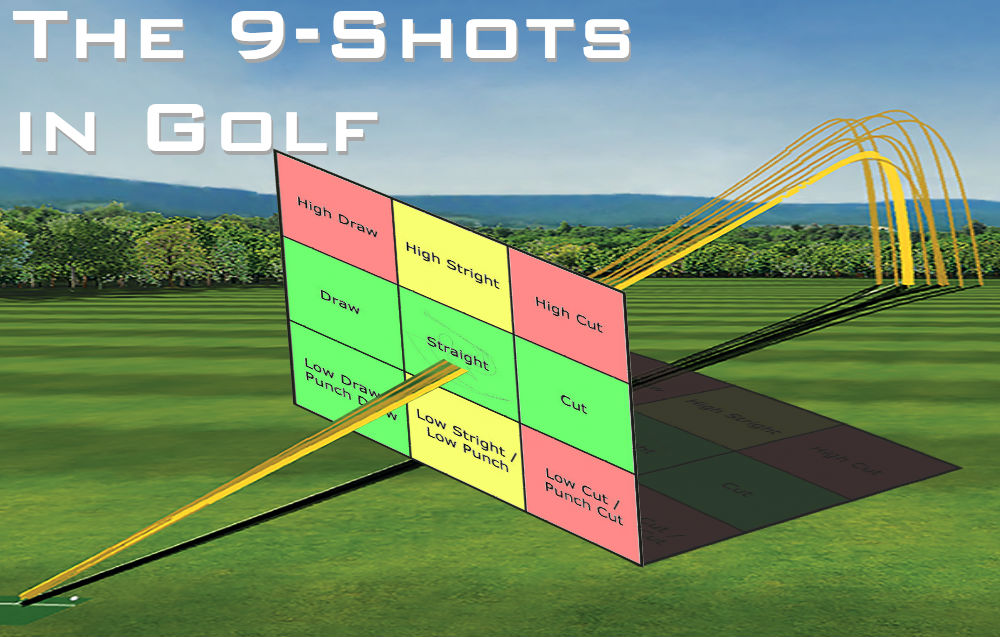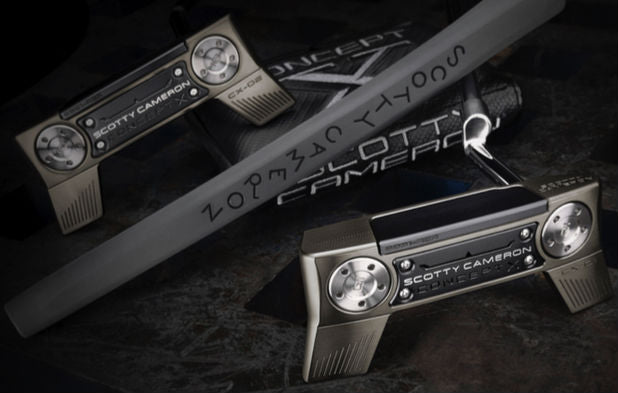
Comparing 7 Iron Lofts - 2018
If you're not getting fit for your clubs, chances are your purchasing on emotion. You're trying a club on a range, maybe on a launch monitor in the store, and you're seeing how far your hitting the club. If you hit that new club farther than what you've already got, you're gonna end up buying it. The issue becomes that you're not testing clubs on an equal playing field. Obviously an extreme example to illustrate, the Bridgestone JGR 7-Iron is 26º loft, meanwhile the Bridgestone Tour B X-Blade 7-iron is 35º loft. That's a difference of 9º of loft! One is a game improving iron the other a blade, which is not the point. The point of this article is just to educate that comparing two 7-irons can be more complicated than you think, there is much to take into account.
Below, I've made a comparison chart of current 7-irons (as of Feb. 2018) showing that lofts and club lengths can vary from manufacturer to manufacturer, and even model to model from the same manufacturer. When we fit in our studio, we try to educate our customers that not all 7-irons are equal. First and foremost, we fit for accuracy first, not distance.. We are not helping you if the longest ball you've ever hit is the farthest in the woods you've ever been.
7-Iron Comparison by Loft

Of the 59 irons surveyed in the chart, if a traditional 7-iron is 34º (thanks to this GolfWeek article), that means 15 of them are 34º or 1º weaker than traditional loft, AND 44 are 1º or more stronger. So, there is obviously a new standard that the club-manufacturers have begun, so lets say the NEW 7-iron loft is 32º (compared to the old 34º).
Even after the "New" loft of a 7-iron, most irons are still stronger. If your iron set is more than 5 years old (...ish), its not always that these clubs are designed with better technology, its only because of strong lofts.
The chart below explains how many models by the OEM are traditional lofted or strong lofted. This chart is good at illustrating that OEM's are designing equipment to sell on emotion. Selling you on emotion that their clubs are somehow hitting the ball farther than their competitors. Which they are hitting farther, no doubt... But lier lier pants on fire, they make you believe that its because of design innovation, not mentioning the lofts.
| OEM | Number of Models ≤32º (NEW Traditional Loft or weaker) | Number of Models ≥ 33º (Strong Lofted) |
|---|---|---|
| Bridgestone | 2 | 2 |
| Callaway | 3 | 8 |
| Cleveland | 0 | 3 |
| Cobra | 2 | 4 |
| Mizuno | 4 | 2 |
| PING | 2 | 4 |
| PXG | 1 | 2 |
| Srixon | 2 | 1 |
| TaylorMade | 3 | 3 |
| Titleist | 4 | 2 |
| Wilson | 4 | 2 |
At quick glance, you can see Callaway leads the pack with the most irons offered with stronger "juiced up" lofts. Meanwhile, on the other side, Mizuno, Titleist and Wilson are keeping to traditional lofts. Also note, that Callaway releases new clubs 2 or 3 times a year, and Mizuno, Titliest and Wilson keep to a 2 year cycle before replacing an iron model. Callaway is obviously chasing the emotional purchase (which, in my experience, most of my emotional purchases I've ended up regretting), and Mizuno, Titleist and Wilson do not chase the emotional golfer. This can explain why these companies receive the highest integrity and quality review via "The One Word Survey" by MyGolfSpy. This article was absolutely fantastic, I highly recommend giving it a look.
Iron Loft & Club-Length Theory
As a general statement, the larger the cavity and more forgiving the club, the stronger the loft. This thought of club design derives from the idea that, someone who needs the forgiveness (senior, junior or lady golfer) most likely also needs distance. A senior golfer needs stronger lofts to make up some distance so they have a chance of keeping up with longer hitters and longer courses. So, as illustrated in the chart below, you'll see the stronger lofts in clubs like Bridgestone JGR iron (identified as game improving) and the Callaway Epic Star (identified as game improving), both have lofts at 26º. Make no mistake, it's not because they designed the best, ball speed creating, new material using iron ever... They juiced the lofts.
In relation to the last paragraph, the smaller the cavity and less forgiving the club, the weaker the loft. This thought of club design derives from the idea that, someone who can hit the ball, and loves to work all 9 flight shots that every club offers, most likely does not need extra distance. With that kind of skill they are probably already hitting far enough and distance is not an issue for this golfer. Thus, weaker and more traditional lofts. However still, many of these golfers come into the shop and ask us to bend their lofts stronger. Why? Because everyone is looking for more distance, maybe because some old guy is hitting almost as far as he is, and shouldn't be. An issue arrises that when you bend an iron/wedge, for every 1º degree bent stronger, you loose 1º of bounce in the sole. When keeping loft progression to the longer irons, like 3, 4, 5 irons, they only have 2º or 3º of bounce or less, now you have a club that could potentially have 0º or negativeº of bounce. This creates a sharper leading edge, interfering with the clubs turf interaction, now your taking deeper divots and more wild missed shots. In another blog I've written, testing the AP3's, I raved that it was a great club, and got some kick-back that I was biased, and lop-sided on the article that I was "pro-Titleist". They missed the point of the entire blog... My point was Titleist offered a players iron (not game improving) with stronger lofts already built in. That is what makes the AP3's a different offering that was not available prior (from Titleist). You could have stronger lofts, but still keep the appropriate bounce in the sole.
7-Iron Comparison by OEM

Final Thoughts
Deep down inside, I really want to call bull-s*%# on some companies that spend millions on marketing campaigns that lie to customers/golfers, insisting that they've developed some new technology method that hits the ball farther with higher ball speed, blah blah blah. These companies do not have the game of golf in their best interests, its profit motivated. But I really can't do that, because there is something to say about golf courses getting longer, and we need longer hitting clubs to feel like we can be competitive. Watching the 7-iron lofts change so much makes me ask more questions. Did the golf course get longer becuase the equipment got stronger? Or, did the equipment get stronger becuase the golf course got longer? Is it because no one wants to "tee it forward"? Or is it really profit motivated, forcing us to have to purchase more hybrids, which are even more expensive than an iron, double or triple the price?
I'll leave it at this... I don't want to control this conversation, tell me what you think! Comment below, what are your thoughts on anything I said, and lets have a conversation. What do you think?
Golf Iron Lofts, Comparing Iron Lofts, Golf Iron Loft Comparison, Golf Irons, Golf Iron Loft, Golf Iron Comparing Length, Lengths
18 Responses
Vincent Smith
Courses are longer because the ball is longer and the equipment allows the athletic player to swing faster while still keeping the ball in play. None of this involves lofts. Player limitation start off the tee. If they end up 170 yards from pin/green they are going to use the club that will get them there. From here it’s their belief/approach, i.e., are they realistic, do they want to assure carrying hazards, etc. In the end, stronger lofts are feeding player egos if they are involved in possible gamesmanship.
Simonevery
All that matters is the score you achieve and that your having fun
Lee Layfield
I agree with everything you said. I’m a 15 handicap using 09 Taylor Made GI clubs that I bought used three years ago (not fitted for me). If they can make clubs that give me 5 iron distance with 8 iron height using a 7 iron I’m all for it. I went from 120s to mid 80s with the clubs I have. Just imagine what I can do with new, custom fitted G 700s? I’ll be ready for the Champions Tour! Maybe one day I can afford them.
Thanks
Lee
Pat Monroe
Love this article, though it may have confused me ever more. I have been playing my G-15 Pings for about 5 years or so. I had them fit by Ping on two occasions and finally requested flat because of having to work too hard to hit them clean most recently. When I did hit them correctly, they were spot on my expected distances. Being frustrated with having to work so hard to set up for the shot to hit them well, I ordered a used set of Callaway Rogues from Ebay (ladies). Life was easy, never a mishit, but always about 5-10 yards short. That means it takes a 6 to hit a 110 yard shot, and then usually over. I was so on target previously that it was very discouraging since I was so on target previously when they were hit correctly, but that is like have a half shoe size and making it work. After reading several comments, I guess my answer is, get used to it, but I have been trying to understand all this baloney about lofts and shaft length to try and fix my problem and use the Callaway’s. I understand that silly game they play with the numbers making us all think we are stronger and better, but I really want ease and control first. I returned the Callaway clubs but am thinking I made a mistake in doing that at this point. Thoughts?
Jay
I came across this thread trying to better understand why I just went to a fitting and “gained” 18 yards of carry on my 6-iron. Is it the tech…or the marketing? My gamer 2013 x hot pros, which I was fitted for, have stiff kbs metal shafts and a 6 iron loft at 27 degrees, which to my surprise was only 0.5 degrees weaker than most of the irons I recently tested out. At the recent fitting, by the time we found a head that I liked the look and feel of – TM p790 head – we worked through a bunch of shafts to get the best combo of narrow dispersion and length. Ball speed increase went from 109.4 to 118.4; clubhead speed also picked up 2.5mph. Bottom line – if it was just the loft of the iron, then one would expect to see distances be roughly the same. It may not all be the club head itself, as there is no doubt the shaft has some impact, but I can say with confidence that my distance increase had nothing to do with loft and marketing. (FYI – my x hot 7 iron was 31 degrees, TM p790 is 30.5). Went out on course…normally I hit my 6 iron 165, and my new 6 was going about 185.
Jim Cavanagh
I think the important thing is to know your own clubs or have them fitted to get what you want. Comparing is interesting, but your own game is most important. My question is a simple amateur thing: How does Tiger hit a 6 iron 215, or a and wedge 145? I know there are variables, and certainly differences in technique, and would like to know what these are. Also, I have heard tat pro irons are delofted both by design and at impact, but is there a difference in loft pysically and how is this applied up through the irons? Thank you!
paul hughes
Your greater than and less than (or equal to) signs appear reversed, unless I am missing something. The loft of a weak lofted club would be greater, not less, that 32 degrees. My 2003 MP33 7 iron is 36 degrees, so your 34 degree “traditional” was already juiced.
This is not all phony. A cavity backed club, with a higher MOI, will have a low effective center of gravity which will cause some players to hit the ball too high, so a lower loft is both doable and desirable.
Kevin Hall
Good article. I have always known that companies play around with lofts on clubs to “create more distance”, but it really doesn’t matter to me. I have been hitting Cleveland TA4s forever. These are great clubs. The problem is that I’m 57 years old now, and I’ve been having trouble getting the irons in the air like I used to, especially the mid and long irons. I’ve been strongly considering the Callaway RAZR HL irons to remedy this (yes, I know they are several years old, but that’s fine by me). Is this a good choice?
Eddie Pabon
This was exactly the article I needed to read. It’s as I suspected. Now, I’m not naive when it comes to marketing and the technology spin, however, I think there’s something to be said about new golfer’s playing irons that might bring them some confidence when they hit the ball also. I think this is a positive in some of the loft changes, or sizes of the heads in game improvement irons. I happen to be an example. I started 4 years ago with the Callaway XR. I bought them used and I believe anyway that the clubs gave me a foundation that I could grow from. As I studied more and my game improved, I now play the Mizuno MP 18 MMC. I strike the ball better, I’ve sacrificed the distance in those irons for other options. Looks in the smaller head and thinner top line. I also get more spin and stopping power when hitting greens. I also get more feedback when I have a miss hit.
I would never know to consider these things had I not started somewhere by comparison or studied the game more. I will say, being able to hit a bit further with that chunkier, game improvement iron early on, kept me in the game.
Great article. I appreciate the hard work that went into it. Thank you.
Sam Campbell
Really appreciate the facts as laid out here. Like the author, I cannot get fired up over this because the stringer lofts work well….those that want traditional lofts can have them. Technology has enabled companies to strengthen lofts while maintaining or even increasing trajectory. In modern cavity back designs, stronger lofts prevent hitting irons too high. Yes, and also producing more distance. It is what it is…I buy irons that fit my game and I enjoy playing. I don’t get stuck on the “why am I hitting it farther than I did 20 years ago?”
Dennis Morrison
The changing of so called standards in golf clubs is a travesty perpetrated on the average golfer because some manufacture wanted to be able to claim their clubs hit the ball farther than other manufactures. Your article puts this marketing ploy into perspective. I personally find that shorter shot making courses are much more fun to play than ones that require you to wind up with everything you have to hopefully reach the green in regulation.
Akira
I went to a local shop to compare my Nike VR Pro Cavity 7 iron against current irons. I was hitting the Callaway Epic Star 160-165 which is about 1-1.5 clubs longer. I now realize that this 7 iron has the loft of almost my 5 iron and this areticle saved me nearly $2000.
Steve
I play a set of Wishon 560MC irons that have the more traditional lofts. Hit the 6 iron in the 150 range.
Love it when I play with someone new and they ask what I hit on a typical par three then I watch them hit their “jacked up lofted” 6 iron over the back into the lake. As stated above the best is to get fitted then know your numbers for a given club. Makes the game much more enjoyable.
Edoardo
Great article, pure facts. I ended up here exactly because of lofts and wild distances. Unfortunately emotions did play a role in my fitting last year (was that unbiased?) and today I’m regretting my purchase, looking forward to go back to more stable and under control irons. We need more knowledge, easy to read information, and – re some companies – less marketing bulsxxxit!
Peter
Great article!!! I liked it a lot! You missed just one fair comment from manufacturers. Titleist claims, that AP1 has 30deg of their 7 iron also because simply the center of gravity is so low that a 7 iron with 34deg with go just too high. I have 718 AP1 and I must say that I hit it really as high as the previous set of clubs with 34 deg 7 iron. Sure, 30deg loft adds also distance, but not at the expense of nice flight curve. So this is really a point to consider, relation between center of gravity and loft. Players irons are indeed shorter, and have more spin. Simply because the top players deloft the club at impact more that amateurs, which combined with high swing speed means enough distance, so they prefer more spin and more steep angle of landing. Basically a hacker with 30deg AP1 7 iron gets as similar trajectory and distance as a pro with 35deg 7 iron, as is possible given the difference in swing speed and sacrifying some spin.
Brian Alksnis
I dont think companys should have #’s on clubs anymore, just loft degrees….
James
You are a genius! Nothing but the truth from this article. Pay attention people. Spend your money wisely. Get fitted at Spargo!
Leave a comment
Comments will be approved before showing up.
Also in Blog

PING G410 Hybrid vs G410 (XR) Crossover - Review

How To Practice Golf And The Shots You Need To Learn
“The definition of insanity is doing the same thing over and over again, but expecting different results”
- Albert Einstein



David Hammond
June 01, 2019
YES the lofts on Iron #N from the distant past to Iron #N at now have gotten lower and almost without fail inside the same manufacturers. That is factual. But it is also along with better GI head design. The typical GI club of 15-20 years ago was a SHOVEL. Awful to look at, took giant divots, strained your lower back, and left you with Golfer Elbow (such as the Ti100). Current GI irons are much more elegant and simply products of better overall engineering — not JUST lower lofts as this article tends to make as its primary assertion. IOW, along with “stronger” lofts (that is lower degrees of loft), the understanding and delivery of lower centers of gravity, perimeter weighting, et al, are all better. Arguably, there has been more DRAMATIC improvement in GI irons than substantial change in blades. Now for all irons, the graphite shafts, even on stock builds, is MASSIVELY more consistent and true to stated intent. So if the senior / lady golfer is hitting 7 iron farther and yet higher, it is both “stronger” lofts (that is lower degrees of loft) AND improvements in head design along with graphite shafts that have vastly improved in stock offerings.